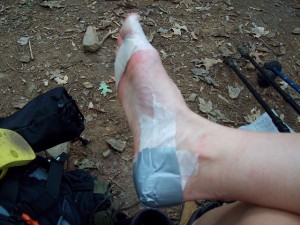Nothing can put the halt on a hiking trip faster than sore feet. Learn how to properly maintain feet and prevent annoying blisters while hiking.
For the beginner hiker, one of the most important things about hiking isn’t the type of backpack carried or even finding the lightest tent. No, the most important thing for a hiker, even an experienced hiker, involves proper foot care. The feet are the work horse for the entire trip, and trying to walk with blisters or cracked calluses can put a swift end to the hike.
Finding the Right Boot
The first thing the hiker should do is invest in a proper pair of hiking boots. Look for a boot that provides good all around support and a comfortable fit. Try the boots on with the same socks that will be used on the hike. Make sure there are no pressure points on the foot and that the toes do not touch the front or top of the boot.
It’s also a good idea to try boots on later in the afternoon after the feet have expanded from the day’s activities. The actual act of hiking will cause swelling of the feet and it’s important to make sure the boot can accommodate them comfortably. Secure the boot around the ankle to prevent foot slippage within the boot.
Before beginning any long hike, make sure the boots are well broken in. Try to log at least 50 miles on them before heading out on any serious hike. It’s also useful to practice shorter hikes while carrying a fully loaded backpack. This will help condition the feet for the upcoming trip.
Hiking Socks
The socks are just as important as the boots. Choose a sock with wicking materials to help pull heat and moisture away from the foot. Avoid socks made of cotton and instead, opt for wool, silk, or other synthetic materials. Select a sock that provides ample cushioning, while at the same time keeping the foot cool and dry.
The main causes of blisters are heat, moisture, and friction. Friction can be caused by debris in the shoe such as sand, or by the act of the foot rubbing against the boot. Use a sock liner designed specifically for wicking underneath the actual hiking sock. This simple trick can be a foot saver.
Prevention and Care of Foot Blisters
Stop hiking at the first sign of discomfort and remove boots and socks. Allow the feet to rest and air dry. Examine the feet for hot spots and blisters. The rule of thumb for blisters is to not pop them unless absolutely necessary. Instead, apply moleskin or duct tape over the sensitive areas and then change into a clean, dry pair of socks before moving on. Moleskin can be found in most drug stores on the foot care isle. If prone to blistering, apply moleskin before starting the hike.
Another common foot problem is cracked calluses. A temporary fix is to apply superglue to the cleaned crack and then condition the area with a moisturizing lotion. Removing calluses and conditioning the feet before setting out on a hike is preferable to on-the-trail foot maintenance.
Hiking Maintenance
Stop every couple of hours to rest the feet and examine them. If the opportunity presents itself, go ahead and soak them in a stream, but remember to dry them thoroughly before putting socks back on. Hiking feet need pampering, so spend a few extra minutes whenever possible to keep them functioning properly. The hike will be much more enjoyable without the complications.
This article is copyrighted by Beverly Hill


Pingback: Hiking the Florida Trail: Titi, Catface and Alaqua Sections | Northwest Florida Outdoor Adventure